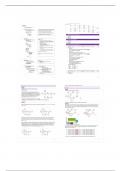Samenvatting
Volledige samenvatting - project management and scheduling - 16/20 - Erik Demeulemeester -
- Instelling
- Katholieke Universiteit Leuven (KU Leuven)
In deze samenvatting vind je: - een duidelijk beschrijving van ALLE te kennen leerstof - de werking van de algoritmes uitgeschreven + extra uitleg - de belangrijkste info uit de academische literatuur die als aangeraden om te lezen beschouwd wordt, dit zal je veel tijd besparen! - de oefeningen...
[Meer zien]



